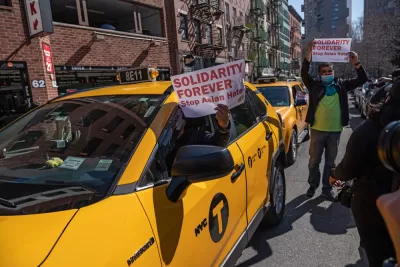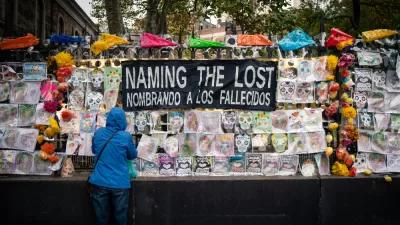The latest in a series of compendia collecting news and commentary focusing on the complexities of the COVID-19 pandemic's effect on communities.

Ever since the early days of stay-at-home orders, the hope for a silver lining has persisted—that the response to the unprecedented economic and public health pressures of the past year might move society and the planet in a more prosperous and sustainable direction.
That hope for a better future was apparent in the way we talked about the clean air and water of the first weeks and months of the pandemic "lockdown." It showed up on the campaign trail, as the ultimately victorious Bien campaign adopted the slogan "Build Back Better"—a phrase that has been mimicked many times since—to describe its recovery plan.
Speaking of mimicked phrases, how many times have you seen Winston Churchill quoted in the past year? Churchill is quoted as saying, "Never let a good crisis go to waste," in the middle of World War II (although the origin of the phrase is still subject to debate). The phrase has been trotted out repeatedly in the past year, as it has been seemingly every time the world has been turned upside down since the middle of the 20th century.
Quoting Churchill and campaigning on slogans like "Build Back Better" is the easy part, however, because there is no consensus on the forms a brighter future might take—notions of a better future forged diverge quickly after passing through the prism of public perception and the politics of the built environment. Many looked to the expansion of car-free streets and al fresco dining as a sign of a more humane and healthy future. Others saw the shift in the use of the public realm as another sign of systemic inequality.
Others saw the growing numbers of urban residents decamping cities like New York and San Francisco for more suburban climes as a sign of the free market's final, inevitable victory. Others saw the "urban exodus" as a sign of congestion and carbon emissions to come.
The divergence continues. Eventually, automobile drivers pushed back on the lack of parking, and the same decline of driving that helped clear the air in the spring of 2020 eventually started killing more pedestrians and drivers per miles traveled than ever before.
We've seen similar questions about how to rebuild from mass tragedy before—in New Orleans after Katrina, New York after Sandy, and Houston after Harvey—but never at such a thoroughly national scale. While it was perhaps therapeutic to think of the outcomes of the pandemic in terms of a silver lining, the need to discover these desired silver linings is much more of a necessity when considered in the face of climate change. We must prepare for more such large-scale crises.
Since March 2020, Planetizen has been tracking the stories that have attempted to make sense of the world during the pandemic, and how the pandemic might alter the future direction of communities. Many of the themes have repeated, with only slight variations as the coronavirus has revealed its effects for public health, the economy, and society.
- Haves and Have Nots: Planning and the Deep Divides of the Pandemic (February 2021)
- Density Takes Center Stage in the Pandemic, Again (January 2021)
- Nine Months Later: How the Pandemic Is Changing Communities (December 2020)
- Coronavirus and the Future of Cities: A Final Pre-Election Tour of the Issues (November 2020)
- Do We Know Any More About the Future of Cities Than We Did in April 2020? (October 2010)
- The Media Can't Stop Talking About the End of Cities (August 2020)
- The Great Debate: Will the Pandemic Alter the Course of Urbanism? (July 2020)
- Debating the Future of Cities After the Coronavirus, Volume 3 (June 2020)
- Density Debate Rages Alongside the Pandemic (April 2020)
- Debating the Future of Cities, and Urban Density, After the Pandemic (March 2020)
- Coronavirus and Urbanism (Planetizen Tag)
- Coronavirus and Transportation (Planetizen Tag)
- Coronavirus and Density (Planetizen Tag)
For just about everyone in the nation, it's been at least a year of pandemic life. My last day at the office was March 17, 2020. Something in the ballpark of 550,000 Americans have died of this terrible disease in the process—so any discussion about silver linings is crass vis-à-vis such terrible a terrible scale of loss and tragedy. As is apparent in the news and commentary of the past month, however, we're still collectively trying to find silver linings and identify the lingering threats caused by the multiple crises introduced to the world by the novel coronavirus.
Status Check
- 565,000 More U.S. Deaths Than Normal Since Covid-19 Struck (The New York Times, March 17)
- Virus Did Not Bring Financial Rout That Many States Feared (The New York Times, March 1)
- NY business execs optimistic about city's recovery (Crain's New York Business, March 1)
- How COVID-19 impacted has Chicagoland public transportation workers (Streetsblog Chicago, March 2)
- Empty Office Buildings Squeeze City Budgets as Property Values Fall (The New York Times, March 3)
- The Covid-19 Baby Bust Is Here (The Wall Street Journal, March 4)
- California will recover from the pandemic faster than the U.S., forecast says (Los Angeles Times, March 10)
The New Realities of Housing
- Advocates urge Peduto to ban evictions; administration could introduce bill as soon as next week (Pittsburgh Post-Gazette, February 17)
- How the pandemic has shifted Pittsburgh’s housing market (Pittsburgh City Paper, February 17)
- People are leaving S.F., but not for Austin or Miami. USPS data shows where they went (San Francisco Chronicle, February 17)
- San Diego approves $92.2M in rent relief (The San Diego Union-Tribune, February 22)
- People Aren't Fleeing Seattle. They Just Aren't Moving Here Anymore (Seattle Times, February 23)
- How Serious Is the Bay Area Exodus (UCLA Economic Letter, March)
- Bay Area's migration is real, but Postal Service data shows California exodus isn't (San Francisco Chronicle, March 1)
- Will coronavirus cause a big city exodus? (Center for Economic Performance, March 1)
- New York’s Plunging Rents Are Luring Bargain Hunters to Their Dream City (Bloomberg Wealth, March 2)
- Homeless people exposed to coronavirus were put in hotels. For hospitals, the move paid off (Los Angeles Times, March 2)
- Four lessons from a year of pandemic housing policies (Brookings, March 3)
- The Bay Area migration has turned the Central Valley into a suddenly hot housing market (San Francisco Chronicle, March 8)
- I Moved My Family From Brooklyn to Boulder (The Washington Post, March 8)
- Where Americans Are Moving — and Why They Really Are Doing It (Governing, March 10)
- The Pandemic Ignited a Housing Boom—but It’s Different From the Last One (The Wall Street Journal, March 15)
- Is the pandemic driving rents down? Or up? (City Observatory, March 16)
- Rents for the rich are plummeting. Rents for the poor are rising. Why? (The Washington Post, March 22)
Disparate Impacts
- Local Vaccine Rates Highlight Barriers Facing Black and Latino Communities (Voice of San Diego, February 19)
- New map shows deep inequities in L.A.’s COVID-19 vaccine rollout (Los Angeles Times, February 20)
- COVID-19 exposes the Black community’s long history of housing instability (The Atlanta Journal-Constitution, February 27)
- The COVID-19 Recession Further Undercuts California Women’s Opportunities for Economic Security (California Budget & Policy Center, March)
- Picking Up The Pieces: Pandemic Inequities Pile More Pressure On To Female CRE Professionals (Bisnow, March 7)
- CDC reports says young people of color were impacted disproportionately more by COVID-19 than their white counterparts (The Boston Globe, March 10)
- Long-term unemployment has risen sharply in U.S. amid the pandemic, especially among Asian Americans (Pew Research Center, March 11)
- The uncounted: People who are homeless are invisible victims of Covid-19 (Stat, March 11)
- How the Bay Area’s COVID response failed Latinos (The Mercury News, March 14)
New Travel Patterns
- For Better Health During the Pandemic, Is Two Hours Outdoors the New 10,000 Steps? (The Wall Street Journal, February 14)
- Why a fake commute could pave the way to work-from-home balance (The Washington Post, February 23)
- The True Costs of Working From Home (Bloomberg CityLab, February 26)
- While Most U.S. Workers Stay Home, It’s Back to the Office for Many in Dallas (The Wall Street Journal, March 2)
- How Remote Work Is Reshaping America’s Urban Geography (The Wall Street Journal, March 5)
- Wall Street A-Listers Fled to Florida. Many Now Eye a Return (Bloomberg Wealth, March 10)
- The Washington commute could return by fall for many workers. It won’t be the same as before. (The Washington Post, March 13)
- A year after gridlock ended, where Atlanta's traffic stands now (Urbanize Atlanta, March 16)
The Uncertainties of Public Transit
- Post-Covid, Transit Agencies Must Look Beyond Ridership (Bloomberg CityLab, February 16)
- Durango Transit contemplates funding as shortfall looms (The Durango Herald, February 17)
- MTA Officials Weigh Whether to Cut New York City Subway Service (The Wall Street Journal, March 1)
- Streetcars and cable cars to return later this year (San Francisco Examiner, March 2)
- How Will Muni Get Its Finances Back on Track? (SF Weekly, March 2)
- The State of Public Transit in Detroit a Year into COVID-19 (Detroit Is It, March 3)
- Federal covid relief package could lift Metro through pandemic budget problems (The Washington Post, March 8)
- Transit Agencies Praise COVID-19 Relief Bill (Next City, March 10)
- Transit Got $30 Billion in Stimulus Aid. What Does That Mean for Riders? (The New York Times, March 15)
- Metro accelerates plans for 'normal' bus service in Houston in August (Houston Chronicle, March 22)
In Search of Silver Linings
- How to Draw People Back to Appalachia—Family Builds a New Life in West Virginia (The Moundsville Blog, February 19)
- Reducing commuter misery is essential to ending NYC’s ‘Ghost Town’ of shuttered stores (New York Post, February 22)
- Set children free: are playgrounds a form of incarceration? (The Guardian, February 25)
- Urban mobility strategies during COVID-19 (EIT Urban Mobility, March)
- 2021 Poverty Projections: Assessing Four American Rescue Plan Policies (Urban Institute, March)
- Don’t Flatten the Curve on Urban Innovation (Bloomberg CityLab, March 1)
- From Emergent to Permanent: 3 Steps to Transform Cycling Infrastructure Beyond the Pandemic (TheCityFiz, March 1)
- Better Parking Management Can Help Cities Recover from COVID and Achieve Public Policy Goals (TheCityFix, March 3)
- When will America’s cities come back from the pandemic? (The Washington Post, March 4)
- When The Home Is The Hazard: Pandemic Responses Must Address Housing Conditions (Next City, March 4)
- 'A rising from the ashes': seeds of hope in San Francisco after tragic year for the most vulnerable (The Guardian, March 7)
- Less traffic, more death: A bizarre 2020 should make us rethink our transportation priorities (Frontier Group, March 9)
- On Shame and Healing (The Nation, March 10)
- The Coronavirus Made the Radical Possible (The New York Times, March 11)
- A year of change on Pico Boulevard (Los Angeles Times, March 17)
- Seizing the Urban Opportunity (Coalition for Urban Transitions, March 17)

Planetizen Federal Action Tracker
A weekly monitor of how Trump’s orders and actions are impacting planners and planning in America.

Restaurant Patios Were a Pandemic Win — Why Were They so Hard to Keep?
Social distancing requirements and changes in travel patterns prompted cities to pilot new uses for street and sidewalk space. Then it got complicated.

Map: Where Senate Republicans Want to Sell Your Public Lands
For public land advocates, the Senate Republicans’ proposal to sell millions of acres of public land in the West is “the biggest fight of their careers.”

Maui's Vacation Rental Debate Turns Ugly
Verbal attacks, misinformation campaigns and fistfights plague a high-stakes debate to convert thousands of vacation rentals into long-term housing.

San Francisco Suspends Traffic Calming Amidst Record Deaths
Citing “a challenging fiscal landscape,” the city will cease the program on the heels of 42 traffic deaths, including 24 pedestrians.

California Homeless Arrests, Citations Spike After Ruling
An investigation reveals that anti-homeless actions increased up to 500% after Grants Pass v. Johnson — even in cities claiming no policy change.
Urban Design for Planners 1: Software Tools
This six-course series explores essential urban design concepts using open source software and equips planners with the tools they need to participate fully in the urban design process.
Planning for Universal Design
Learn the tools for implementing Universal Design in planning regulations.
Heyer Gruel & Associates PA
JM Goldson LLC
Custer County Colorado
City of Camden Redevelopment Agency
City of Astoria
Transportation Research & Education Center (TREC) at Portland State University
Camden Redevelopment Agency
City of Claremont
Municipality of Princeton (NJ)





























